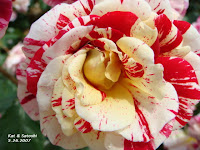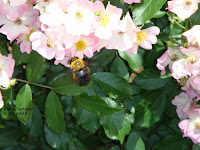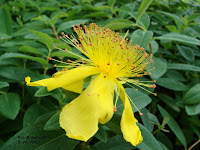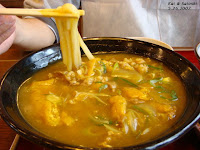
Friday, it rained ALL day long. Waking up to a sunny day on Saturday, we decided to do some gallivanting.

It is rose season here. We made our way to the Aramaki Rose Garden in Yamamoto (about four stations away from ours). Last year, we visited this garden three times, two times in
Spring and once in
Fall.

The rain from the day before combined with the heat of Saturday made the roses seem a bit droopy and tired. So there wasn't that vibrant spark.

Still, you could smell the light rose fragrance and the bees were happy. (That bee in the photo was two times the size of a normal honeybee! Yipes!)


Besides roses, I also found some interesting flowers. (sorry, I don't know the names of them.)

For lunch, we walked to a restaurant near the Yamamoto station and had noodles. Satoshi had a curry udon, they were nice enough to give him a bib so that he wouldn't splatter himself with the curry sauce/soup.
After lunch we did more galivanting, like go to the airport to check out their interior shop's renovation and going to the neighborhood library to donate some books.

Dinner was a new recipe. Since I still had some veggies leftover from making
ratatouille (I really bought a lot!), they were perfect for this dish.
Nasu to butaniku no kotterini (eggplant & pork in a rich sauce) translated from "Orange Page's Obaachan no Aji--Book 5" Serves 4
4
nasu (eggplant)
150g
butakomagire (chopped pork)
200g
shirataki* (thinly sliced devil's tongue jelly)
8 okra
oil for frying
Soup
2 cups
Dashi (stock)
1.5 tablespoons
mirin (sweet rice wine)
1.5 tablespoons
sake (rice wine)
2 tablespoons
shoyu (soy sauce)
ginger juice
1. In a pot, put the shirataki in and cover with water, boil for 6-7 minutes. Drain well and tie about 10 strands in a knot. Repeat until all shirataki are tied. *
Shirataki (Kanto) is also called
Itokonnyaku (Kansai). You can also find it already tied, in this case, just boil for the 6-7 minutes.
2.Cut the top off the eggplant and split the eggplant lengthwise in half. Wipe well. Make slanted cuts in the skin like a lattice but not enough to cut through the eggplant.
3. Fry the eggplant in some oil for about 1 minute turning frequently. Take out and drain on a paper towel. Next, fry the okra until the color turns vibrant green and put out onto a paper towel.
4. In a pot, put the shirataki in and heat to evaporate any water. Add the pork and cook until it turns color.
5. Add the stock and bring to a boil. Add the rest of the soup ingredients and cover with an
oshibuta (drop lid), if you don't have one, make one with foil. Be sure to make it one size smaller than the pot and put two holes in the center, it should look like a pig's snout. Cook on medium heat for 7-8 minutes.
6. Move the shirataki to the side of the pot and add the eggplant and okra. Cook for another 3-4 minutes. Turn off the heat and add the ginger juice.
NOTES: I read somewhere that shirataki when cooked next to meat makes the meat tough. Following this recipe, the meat became quite tough. For step #4 after the shirataki's water is evaporated, take it out and then cook the pork. Add the shirataki back in before cooking for the 7-8 minutes.
This dish is great with lots of rice and beer :)

It was a great Saturday.
 After hearing about a carrot salad on Bea's blog, I googled a recipe from Orangette. The salad is very simple and apparently can be found in many French bistros. Here is the post with the recipe on Orangette.
After hearing about a carrot salad on Bea's blog, I googled a recipe from Orangette. The salad is very simple and apparently can be found in many French bistros. Here is the post with the recipe on Orangette.


















































